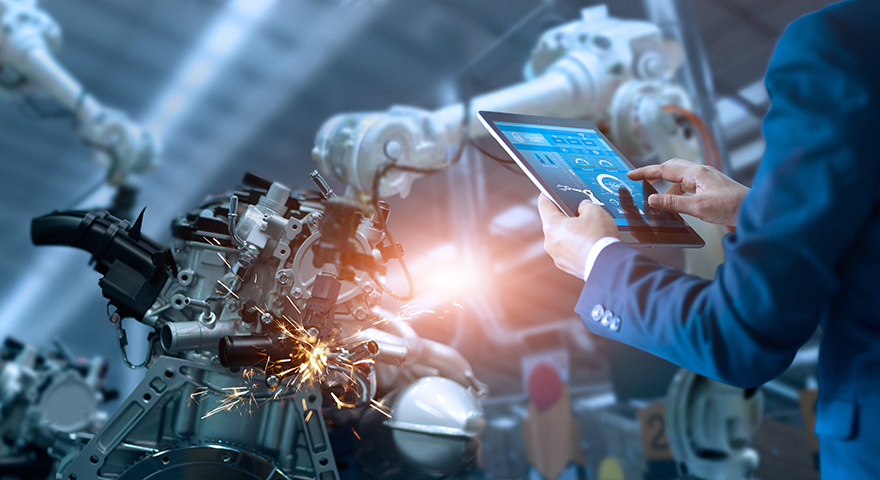AI creates a new industrial age

Digitization has been as revolutionary for industry as the introduction of electricity. Now artificial intelligence (AI) and big data are generating new opportunities – and a number of challenges.
In the “Artificial Intelligence in Europe” report published by consultancy firm EY, some 57 percent of the companies surveyed expect AI to have a significant or very significant impact on business areas that are “entirely unknown to the company today,” and 65 percent expect AI to have a significant or very significant impact on their core business.
Changing the game
“The opportunities generated by digitization in general are game changers in most sectors, which is one reason why digital solutions have gained a strong foothold in different parts of society,” says researcher Daniel Langkilde, who develops AI solutions for Scania, Volvo and other major companies.
Digitization lays the foundation for entirely new business models, sometimes simultaneously throwing out the old models. A new model could be based on servitization, with revenues being secured directly by the performance of the products. This creates an incentive for suppliers to constantly optimize the outcome, which has also become easier through digitization, Langkilde explains.
More and more things are being equipped with sensors, giving us more data
“When the machines are equipped with sensors that measure a range of different parameters, it’s possible to schedule maintenance to secure operations,” he says. “But there is also a possibility of using sensor data and AI to gain a clear picture of the customer’s actual usage and to suggest methods or equipment that can improve productivity.”
One big solution
The data volumes generated can also be analyzed and used as a basis for developing the product range even further. Petra Sundström, Head of Digital Business Development at Sandvik’s Crushing & Screening Division, emphasizes that new technologies per se are not something new. What’s new is that the digital technologies we see today, like AI and Internet of Things (IoT), serve as a glue that connects several different areas.
“Previously, we could basically produce hardware – unique and highly skilled products – and then leave them with the customers. Now we have to keep doing that, and at the same time understand that the products need to tie into services, to the aftermarket, to brands, to customers and to a lot of different stakeholders. It’s becoming one big solution product.”
 Digitization lays the foundation for entirely new business models, sometimes simultaneously throwing out the old models.
Digitization lays the foundation for entirely new business models, sometimes simultaneously throwing out the old models.
Magnus Ekbäck, Vice President Strategy and Business Development at Sandvik Coromant, summarizes the main trends driving the digitization of the manufacturing industry: “More and more things are being equipped with sensors, giving us more data. At the same time the connectivity has improved fast and the demand for using data in the decision-making process has increased quickly. These three factors together are important in explaining the automation of the manufacturing industry that we see today; they are the enablers.”
“The term ‘Artificial Intelligence’ can be misleading, because computers that make calculations and analyses are actually nowhere near intelligent in the usual sense of the word,” notes Langkilde. “But they can learn to see connections by being fed large volumes of data, and the more data they receive, the better their analyses become.”
Jan Ekstrøm at IBM Watson IoT Europe agrees with Langkilde. He sees AI as “augmented” rather than “artificial” intelligence. Industrial developments are not focusing on any form of AI in which machines will be taking over the world as soon as they get smart enough, he says, adding:
“That’s just science fiction. AI is about developing the capacity of machines by equipping them with advanced algorithms and feeding them with huge amounts of data. It’s not at all the same as intelligence in the traditional sense; it’s more a way of calculating complex relationships, making life simpler, more efficient and safer for companies and the people working in them.”
Opportunities abound
Some other opportunities that AI can offer are monitoring processes to see where there is potential for making things more efficient and starting to use collaborative robots – robots that work with people or with each other.  Daniel Langkilde develops AI solutions for major industrial companies: “The opportunities generated by digitization are game changers in most sectors.”
Daniel Langkilde develops AI solutions for major industrial companies: “The opportunities generated by digitization are game changers in most sectors.”
There may also be more strategic areas of use, such as detailed scenario planning or researching a large number of possible design variants of a new product.
These opportunities, however, present companies with brand new challenges: “Going from being a product supplier to a service provider, with all that this entails in terms of everything from revenue flows to corporate culture, is a major challenge. Another challenge is knowing exactly which solutions could drive business. A regular industrial company does not currently have this kind of expertise. There will be a powerful tug-of-war for skills in the labor market of the future,” Langkilde concludes.